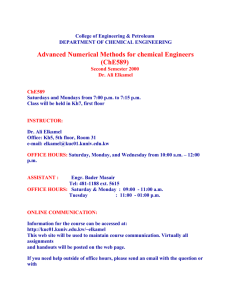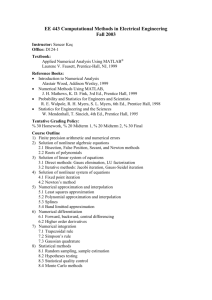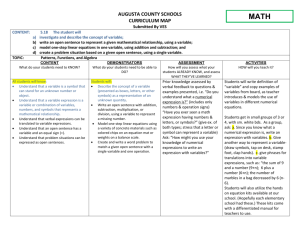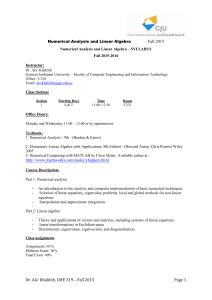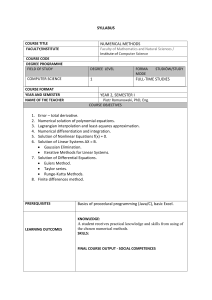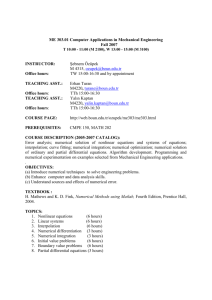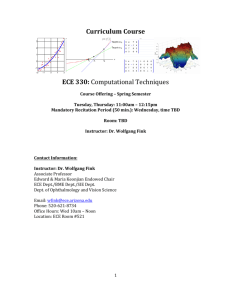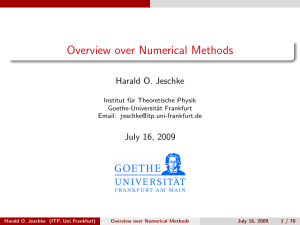CHEE 3334: Numerical Techniques for Chemical Engineers
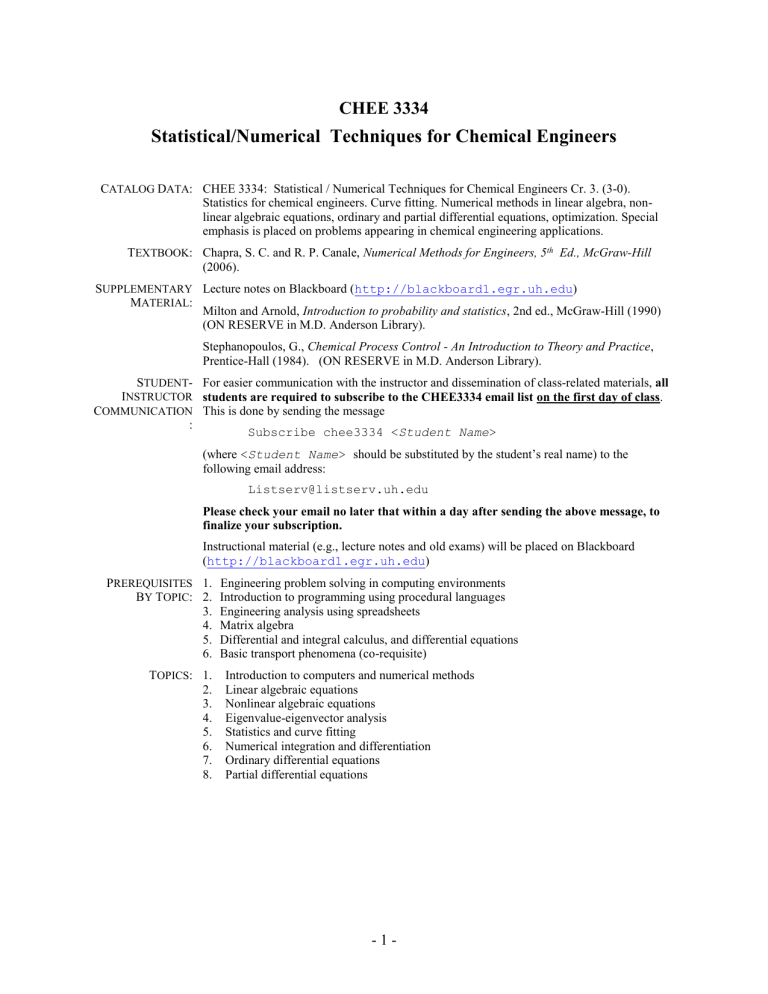
CHEE 3334
Statistical/Numerical Techniques for Chemical Engineers
C ATALOG D ATA : CHEE 3334: Statistical / Numerical Techniques for Chemical Engineers Cr. 3. (3-0).
Statistics for chemical engineers. Curve fitting. Numerical methods in linear algebra, nonlinear algebraic equations, ordinary and partial differential equations, optimization. Special emphasis is placed on problems appearing in chemical engineering applications.
T EXTBOOK : Chapra, S. C. and R. P. Canale, Numerical Methods for Engineers, 5
(2006). th Ed., McGraw-Hill
S UPPLEMENTARY
M ATERIAL :
Lecture notes on Blackboard ( http://blackboard1.egr.uh.edu
)
Milton and Arnold, Introduction to probability and statistics , 2nd ed., McGraw-Hill (1990)
(ON RESERVE in M.D. Anderson Library).
Stephanopoulos, G., Chemical Process Control - An Introduction to Theory and Practice ,
Prentice-Hall (1984). (ON RESERVE in M.D. Anderson Library).
S TUDENT -
I NSTRUCTOR
C OMMUNICATION
:
For easier communication with the instructor and dissemination of class-related materials, all students are required to subscribe to the CHEE3334 email list on the first day of class .
This is done by sending the message
Subscribe chee3334 < Student Name >
(where < Student Name > should be substituted by the student’s real name) to the following email address:
Listserv@listserv.uh.edu
Please check your email no later that within a day after sending the above message, to finalize your subscription.
Instructional material (e.g., lecture notes and old exams) will be placed on Blackboard
( http://blackboard1.egr.uh.edu
)
P REREQUISITES
B Y T OPIC :
1. Engineering problem solving in computing environments
2. Introduction to programming using procedural languages
3. Engineering analysis using spreadsheets
4. Matrix algebra
5. Differential and integral calculus, and differential equations
6. Basic transport phenomena (co-requisite)
T OPICS : 1. Introduction to computers and numerical methods
2. Linear algebraic equations
3. Nonlinear algebraic equations
4. Eigenvalue-eigenvector analysis
5. Statistics and curve fitting
6. Numerical integration and differentiation
7. Ordinary differential equations
8. Partial differential equations
- 1 -
EXPECTED
COURSE
OUTCOMES AND
PERFORMANCE
CRITERIA:
1. Demonstrate understanding of the fundamentals of widely used numerical algorithms and their most important mathematical properties ( a ).
1
2. Demonstrate ability to translate a variety of problems in traditional and emerging chemical engineering fields into numerical problems and to tune numerical algorithms for effective and efficient solution ( a, k ).
3. Demonstrate ability to write programs that solve engineering problems ( a ).
4. Demonstrate ability to use software packages for generic or specialized use ( k ).
5. Demonstrate ability to present computer input and output in a comprehensive, comprehensible, editable, and interpretable way ( g ).
6. Demonstrate ability to access bibliographical and Internet resources related to numerical methods ( i, k ).
S TUDENT
E VALUATION :
Computer projects 25%
Exam 1 25%
Exam 2
Final
25%
25%
Total 100%
The computer projects are an important part of the course and should be treated as such.
Problem solutions should be easy to read, and final results should be clearly identified.
Projects will be graded on the basis of both technical merit and presentation.
Projects are to be handed in when due. Late projects will be accepted only under extremely unusual circumstances. If such circumstances appear, students are advised to notify the instructor ASAP. No credit will be given for projects turned in after solutions have been discussed in class.
Requests for re-grading of all work or exams must be made within a week after the work or exams have been returned.
Exam dates will be announced at the beginning of the semester. No make-up exams will be given.
Old exams and solutions (available at ( http://blackboard1.egr.uh.edu
) will be discussed in review sessions prior to exam dates.
1
Lowercase letters in parentheses refer to ABET outcomes under Criterion 3 (see Appendix).
- 2 -
ABET Outcome, Criterion 3
(a) an ability to apply knowledge of mathematics, science and engineering.
(b) an ability to design and conduct experiments as well as to analyze and interpret data.
Appendix
Program-Specific Outcomes
Use chemistry and physics concepts to set up and solve chemical engineering problems
Use mathematical tools to solve chemical engineering problems
Select appropriate experimental equipment and techniques necessary to solve a given problem
Evaluate and interpret experimental results using statistical tools and chemical engineering concepts
Apply material and energy balance concepts to design a unit operation
Define objectives and perform the design of an integrated chemical process under realistic constraints
(c) an ability to design a system, component, or process to meet desired needs within realistic constraints such as economic, environmental, social, political, ethical, health & safety, manufacturability, and sustainability.
(d) an ability to function on multidisciplinary teams.
(e) an ability to identify, formulate and solve engineering problems.
(f) an understanding of professional and ethical responsibility.
(g) an ability to communicate effectively.
(h) the broad education necessary to understand the impact of engineering solutions in a global, economic, environmental, and societal context.
(i) a recognition of the need for and an ability to engage in life-long learning.
Define roles and responsibilities to align with capabilities of team members and fulfill project requirements
Develop and carry out a project plan through team work
Translate an engineering problem into a mathematical model or other suitable abstraction
Use mathematical model or other suitable abstraction to solve an engineering problem and interpret results
Demonstrate knowledge of professional code of ethics.
Identify ethical issues and make decisions for a chemical engineering problem.
Make presentations that are factual and tailored to the audience
Can communicate in writing to non-technical and technical audiences
Understand the impact of chemical engineering solutions in a global, economic, environmental, and societal context.
(j) a knowledge of contemporary issues.
(k) an ability to use the techniques, skills, and modern engineering tools necessary for engineering practice.
Recognize the importance of advanced education and development opportunities
Identify, retrieve, and organize information necessary to solve open-ended problems
Know the interplay between current technical and societal issues
Know the recent history, current status, and future trends of chemical engineering
Use modern software to solve chemical engineering problems
Understand how to operate equipment relevant to chemical engineering systems
- 3 -
